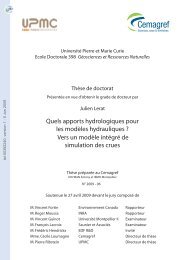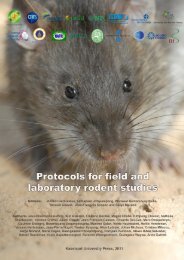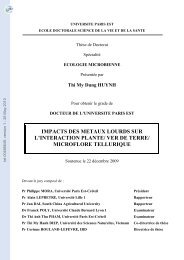Modeling and Inversion in Thermal Infrared Remote Sensing over ...
Modeling and Inversion in Thermal Infrared Remote Sensing over ...
Modeling and Inversion in Thermal Infrared Remote Sensing over ...
You also want an ePaper? Increase the reach of your titles
YUMPU automatically turns print PDFs into web optimized ePapers that Google loves.
10 <strong>Model<strong>in</strong>g</strong> <strong>and</strong> <strong>Inversion</strong> <strong>in</strong> <strong>Thermal</strong> <strong>Infrared</strong> <strong>Remote</strong> Sens<strong>in</strong>g 263ird-00392669, version 1 - 9 Jun 2009atmospheric <strong>and</strong> surface effects [125, 126]. Most <strong>in</strong>vestigations deal with the SWmethod, s<strong>in</strong>ce multispectral observations are more usual than multiangular ones.Various versions have been proposed for Eq. 10.9: l<strong>in</strong>ear or quadratic forms(B = 0orB≠ 0), optional <strong>in</strong>clusion of emissivity (C = 0orC≠ 0, D = 0orD≠ 0),express<strong>in</strong>g coefficients from atmospheric water vapor content. Larger freedom degreesperform better [125, 126, 174, 183, 204]. Waveb<strong>and</strong>s around 11 <strong>and</strong> 12 µmare the most appropriate for SW <strong>and</strong> DA assumptions, s<strong>in</strong>ce they correspond tolow variations of emissivity, spectrally <strong>and</strong> spatially [172, 174]. Calibration relieson simulations from emissivity spectral libraries <strong>and</strong> atmospheric radiative transfer[82, 125, 126, 204]. Operational use requires documentation. Atmospheric watervapor content is <strong>in</strong>ferred from climatological database [183], the SWVCR [198]or near <strong>in</strong>frared radiance ratios [199]. Emissivities are derived from classifications[181, 182, 205], or from Eq. 10.8 with nom<strong>in</strong>al values for soil <strong>and</strong> vegetation emissivities[172, 199].Several validation exercises reported accuracies better than 1 K. Excellent resultswere obta<strong>in</strong>ed from TIMS without a priori <strong>in</strong>formation [172]. Us<strong>in</strong>g classificationbased knowledge of emissivity can perform well [181, 182], though significant subclassvariabilities were observed [206, 207]. However, a 1 K accuracy usually requireslocal <strong>in</strong>formation on surface conditions for emissivity effects. Further, thelack of such <strong>in</strong>formation can <strong>in</strong>duce errors up to 3 K [125, 126, 174, 183, 199].10.6.2.3 Multispectral <strong>and</strong> Hyperspectral TIR Instantaneous ObservationsRadiometric temperature is derived from multispectral <strong>and</strong> hyperspectral observationsus<strong>in</strong>g two step approaches. After atmospheric corrections, the ill posedproblem can be solved us<strong>in</strong>g either a priori <strong>in</strong>formation, or the spectral variabilitycaptured <strong>over</strong> the whole TIR range. This last possibility is very different fromthe two channel SW differenc<strong>in</strong>g which aims at avoid<strong>in</strong>g emissivity variations.For multispectral observations, the NEM approach sets maximum emissivity toa nom<strong>in</strong>al value [208], where the latter can be derived from Eq. 10.8 us<strong>in</strong>g a priori<strong>in</strong>formation about soil <strong>and</strong> vegetation emissivities [173]. The adjusted ANEMrelies on l<strong>and</strong> use [168, 170], <strong>and</strong> the MIR NEM is extended to MIR observations[209]. Rather than us<strong>in</strong>g a priori <strong>in</strong>formation, other approaches aim at benefit<strong>in</strong>g thevariability captured from multispectral <strong>and</strong> hyperspectral data, the latter provid<strong>in</strong>gf<strong>in</strong>er spectral sampl<strong>in</strong>gs. The TES algorithm derives m<strong>in</strong>imum emissivity from thespectral variations, via an empirical relationship verified <strong>over</strong> most l<strong>and</strong> surfacesfor the TIR <strong>and</strong> the MIR doma<strong>in</strong>s [104, 157, 210–212]. Captur<strong>in</strong>g larger variabilitieswith hyperspectral data <strong>in</strong>crease TES accuracy up to 0.5 K [104]. To deriveabsolute emissivity from relative spectral variations, the alpha residuals logarithmicallyl<strong>in</strong>earize Planck’s equation, with an optional improvement based on Taylorexpansion for hyperspectral observations [213]. Taylor expansion also providederivative approaches, such as the “Grey Body” method [123]. F<strong>in</strong>ally, multispectral<strong>and</strong> hyperspectral observations are useful for deriv<strong>in</strong>g broadb<strong>and</strong> emissivity viaNTB conversions [52, 54, 207, 214].Uncorrected Proof
















